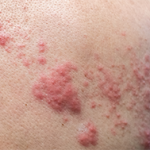(Reuters Health)—Just one in five people over age 60 in the U.S. have been vaccinated against a painful eruption of herpes zoster (shingles), despite recommendations that all of them should get the shot.
It’s estimated that among people over age 50, one in three will eventually develop shingles. After age 80, half of adults have had shingles.
“The rash usually heals within two to four weeks; however, some people develop ongoing nerve pain which can last for months or even years,” says lead author Dongmu Zhang of Merck and Co., Inc., a New Jersey-based pharmaceutical company that makes a shingles vaccine.
“Vaccination of appropriate adults may help to prevent or attenuate herpes zoster,” Zhang says by email, adding that the Center for Disease Control and Prevention recommends it for all adults over 60.
The vaccine is also approved for people aged 50–59, though guidelines stop short of recommending it for that age group. The federal government’s Healthy People 2020 initiative set a goal of having 30 percent of people over 60 vaccinated by 2020, Zhang’s team writes in the American Journal of Preventive Medicine, online Oct. 26.¹
To determine how many older adults are getting the vaccine, the study team used data from two healthcare databases, one including nearly 7 million adults over age 60 and another with 7 million people between 50–60. Researchers looked at how many of them received the herpes zoster vaccine between 2007 and 2013.
They also looked at factors that might affect whether or not people got the vaccine, including age, sex, geographic area, health insurance type and whether or not the person had a compromised immune system.
The team found that by 2013, less than 2% of 50–60 year olds, 24% of adults between 60 and 64 and 15% of adults over 65 had received the herpes zoster vaccine.
The vaccine was first approved in 2006, and the number of people getting vaccinated each year went up between 2007 and 2013, researchers note.
Women and people with normal immune systems were more likely to receive the vaccine, as were people who visited doctors and pharmacies for regular medical care more often. But people who visited emergency departments and had inpatient hospital stays were less likely to get the vaccine.
People who got the flu vaccine were also more likely than those who didn’t to have had the herpes zoster vaccine.
Zhang’s team urges doctors to use routine health encounters like a visit for flu vaccination as opportunities to also educate people about the shingles vaccine and urge them to get it.
“The pain of shingles can be debilitating and is not easily treated,” Dr. Barbara Yawn, a professor at the University of Minnesota in Minneapolis, tells Reuters Health by email.
The pain and itching of shingles can be so bad that people may not be able to do their usual activities, says Yawn, who was not involved in the study.
“In the oldest group, the disability can be so marked that people are unable to provide their own care and become dehydrated and may end up in the hospital because they cannot even get up to get a drink due to the pain,” Yawn adds.
“Shingles is a preventable disease that can have adverse effects on your quality of life,” Yawn says. “It is better to prevent shingles than try to treat after it has occurred.”
“Herpes zoster is a disease that a vaccine may help to prevent, yet the vaccination rate remains low,” Zhang says. “It is imperative that people talk with their physician or pharmacist to determine if they are eligible for vaccination against herpes zoster.”
Reference
- Zhang D, Johnson K, Newransky C, et al. Herpes zoster vaccine coverage in older adults in the U.S., 2007–2013. Am J Prev Med. 2016 Oct 26.

